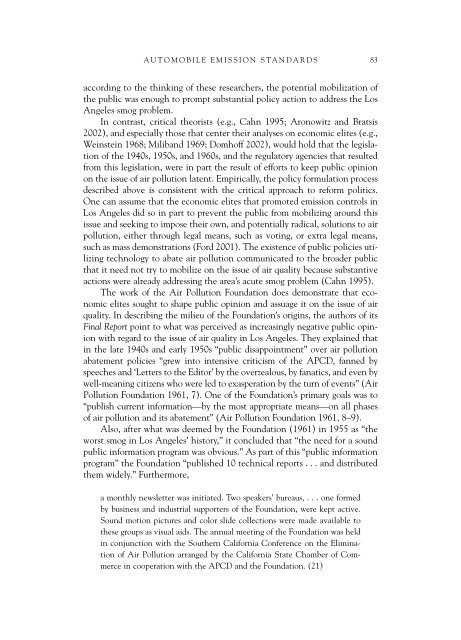GEORGE A. GONZALEZ - fieldi
GEORGE A. GONZALEZ - fieldi
GEORGE A. GONZALEZ - fieldi
Create successful ePaper yourself
Turn your PDF publications into a flip-book with our unique Google optimized e-Paper software.
AUTOMOBILE EMISSION STANDARDS 83according to the thinking of these researchers, the potential mobilization ofthe public was enough to prompt substantial policy action to address the LosAngeles smog problem.In contrast, critical theorists (e.g., Cahn 1995; Aronowitz and Bratsis2002), and especially those that center their analyses on economic elites (e.g.,Weinstein 1968; Miliband 1969; Domhoff 2002), would hold that the legislationof the 1940s, 1950s, and 1960s, and the regulatory agencies that resultedfrom this legislation, were in part the result of efforts to keep public opinionon the issue of air pollution latent. Empirically, the policy formulation processdescribed above is consistent with the critical approach to reform politics.One can assume that the economic elites that promoted emission controls inLos Angeles did so in part to prevent the public from mobilizing around thisissue and seeking to impose their own, and potentially radical, solutions to airpollution, either through legal means, such as voting, or extra legal means,such as mass demonstrations (Ford 2001). The existence of public policies utilizingtechnology to abate air pollution communicated to the broader publicthat it need not try to mobilize on the issue of air quality because substantiveactions were already addressing the area’s acute smog problem (Cahn 1995).The work of the Air Pollution Foundation does demonstrate that economicelites sought to shape public opinion and assuage it on the issue of airquality. In describing the milieu of the Foundation’s origins, the authors of itsFinal Report point to what was perceived as increasingly negative public opinionwith regard to the issue of air quality in Los Angeles. They explained thatin the late 1940s and early 1950s “public disappointment” over air pollutionabatement policies “grew into intensive criticism of the APCD, fanned byspeeches and ‘Letters to the Editor’ by the overzealous, by fanatics, and even bywell-meaning citizens who were led to exasperation by the turn of events” (AirPollution Foundation 1961, 7). One of the Foundation’s primary goals was to“publish current information—by the most appropriate means—on all phasesof air pollution and its abatement” (Air Pollution Foundation 1961, 8–9).Also, after what was deemed by the Foundation (1961) in 1955 as “theworst smog in Los Angeles’ history,” it concluded that “the need for a soundpublic information program was obvious.” As part of this “public informationprogram” the Foundation “published 10 technical reports ... and distributedthem widely.” Furthermore,a monthly newsletter was initiated. Two speakers’ bureaus, ... one formedby business and industrial supporters of the Foundation, were kept active.Sound motion pictures and color slide collections were made available tothese groups as visual aids. The annual meeting of the Foundation was heldin conjunction with the Southern California Conference on the Eliminationof Air Pollution arranged by the California State Chamber of Commercein cooperation with the APCD and the Foundation. (21)









